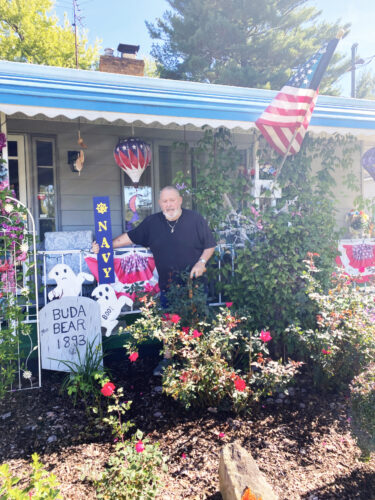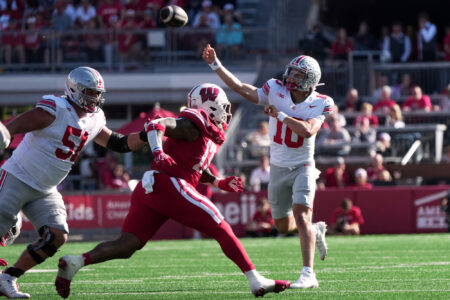Naval duty sends Warren graduate around the world
Warren native Bob Kent earned an All-Ohio Football honorable mention as a member of the Warren G. Harding Panthers in 1959. Kent played center, alongside classmate and NFL Hall of Famer Paul Warfield. Kent also placed fourth at state for wrestling that year.
“I never lost a match by more than one point,” said Kent.
Kent was offered full scholarships to Kent, Hiram and Arizona State, but he opted to enlist in the U.S. Navy Reserve during his senior year, a few months before he graduated.
“I needed money for a suit to take

Submitted photo
Bob Kent, shown outside of his Warren home, played center for the 1959 Warren G. Harding Panthers.
Boot camp took place at the Recruit Training Command,Great Lakes, Illinois. He had a four-day break after boot camp, then returned to Warren before taking a train to Philadelphia while awaiting his ship assignment. He was assigned to a destroyer escort, the USS Rich DDE 820, which was dry-docked at the time in Portsmouth Naval Shipyard, Kittery, Maine.
“There were shipyard workers everywhere,” he said. “I was assigned a bunk locker, told to put on my work clothes, and was taken to the boiler room, as a boiler technician, where I cleaned, painted, and shined deck plates and did engine and boiler work.”
After a few weeks, they left Portsmouth and went to the Norfolk Destroyer and Submarine Piers, where they docked beside a large submarine surrounded by shore patrol. The submarine was the USS Nautilus, the first nuclear submarine. “The 820” was soon on its way to the Atlantic Ocean, where its first stop was New York City. Kent had time there to take some “liberty.”
“What a difference from Warren, Ohio! I saw everything from the Empire State Building to Chubby Checker at the Peppermint Lounge,” he said.
The next stop was Quebec City, then down the St. Lawrence Seaway to the Atlantic, where they met up with the USS Wasp, an aircraft carrier, and the rest of the DES RON 36, which consisted of about a dozen ships, the U.S. Navy’s Destroyer Squadron 36.
“They were escorting the Wasp across the Atlantic, playing or planning war games. I did not see land for about 4 days. I was excited to go to Iceland, the ‘Land of Fire and Ice,’ which was our next stop,” he said.
They were in Iceland for a few days, with limited liberty, because of political unrest. They headed for Gibraltar next, the entrance to the Mediterranean Sea, where the first stop was Montserrat, a mountain range near Barcelona, Spain.
“We went on a tour of Montserrat. We got a glass of wine there from an old man,” Kent said. ”I was the only one who could hold a 5-gallon jug over my head and drink it. My whites got drenched, though. They gave me a goat stomach wine sack with a painting on it.”
Next, they anchored in France, where he was able to meet up for a day with a fellow sailor / childhood friend, Carmen Santone. Then it was on to Genoa, Rome, ending their six months in the Mediterranean in Palermo, Sicily. They spent time in Lubeck, Germany, Amsterdam, Rotterdam, Oslo, and on to Iceland, through the Arctic Circle.
“While in the Arctic Circle, we ran into a bad hurricane, headed back to the North Sea, and ended up on the point of no return two times,” he said. “The waves were 40 feet tall. Fans were blowing water out of the boiler rooms, and we could not eat, sleep, or shower for three days.
“You could not stay on your bunk; you were rolling so much. The cooks could not cook during the hurricane, so they gave us crackers.”
The ship was repaired in Plymouth, England, and they returned to Norfolk, Virginia.
Kent then spent six weeks in Guantanamo Bay Naval Base during the Cuban missile crisis.
“The Russians had missiles in Cuba. We didn’t know if they were bringing missiles in or taking them out,” he said. “While we were there, the USS Boxer came in. It carried troops. We were close to war. It was bad.
“We were following Russian subs. We came to find out six months later that they were carrying nuclear missiles. Thanks to Kennedy, he and (Soviet premier Nikita) Khrushchev made a deal. If we removed our missiles out of Turkey, they would take their missiles out of Cuba.”
Kent was also involved in the rescue of astronaut John Glenn, an Ohio native, after his orbit of the Earth in 1962.
“There was a ship every 30 to 35 miles. We did not know where he was coming down,” Kent said.
Kent’s last stops were in the Dominican Republic, Bermuda and Key West.
“After active duty, I taught classes for the Reserve once a week for the rookies coming in who had never been on a ship, until they closed the place by Warren G. Harding,” Kent said.
Kent was employed by Thomas Steel, retiring in 2001 after 40 years. During his first 10 years post-retirement, Kent and his wife, Donna, traveled to every U.S. national park in their motor home.
Bob Kent
AGE: 84
RESIDENCE: Warren
SERVICE: U.S. Navy Reserve
MILITARY HONORS: Honorable discharge
OCCUPATION: Retired from Thomas Steel
FAMILY: Son, Jason; daughter; Michelle; and three grandchildren

